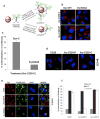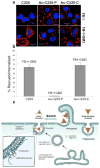Switching the targeting pathways of a therapeutic antibody by nanodesign
- PMID: 22135077
- PMCID: PMC3324088
- DOI: 10.1002/anie.201105432
Switching the targeting pathways of a therapeutic antibody by nanodesign
Figures



Similar articles
-
Designing nanoconjugates to effectively target pancreatic cancer cells in vitro and in vivo.PLoS One. 2011;6(6):e20347. doi: 10.1371/journal.pone.0020347. Epub 2011 Jun 27. PLoS One. 2011. PMID: 21738572 Free PMC article.
-
Gold nanoparticles and radiofrequency in experimental models for hepatocellular carcinoma.Nanomedicine. 2014 Aug;10(6):1121-30. doi: 10.1016/j.nano.2014.03.004. Epub 2014 Mar 17. Nanomedicine. 2014. PMID: 24650884 Free PMC article.
-
Measuring Binding Kinetics of Antibody-Conjugated Gold Nanoparticles with Intact Cells.Small. 2015 Aug;11(31):3782-8. doi: 10.1002/smll.201500112. Epub 2015 Apr 11. Small. 2015. PMID: 25865036 Free PMC article.
-
Design and applications of gold nanoparticle conjugates by exploiting biomolecule-gold nanoparticle interactions.Nanoscale. 2013 Apr 7;5(7):2589-99. doi: 10.1039/c3nr33870c. Nanoscale. 2013. PMID: 23423633 Review.
-
Uptake of engineered gold nanoparticles into mammalian cells.Chem Rev. 2014 Jan 22;114(2):1258-88. doi: 10.1021/cr300441a. Epub 2013 Nov 26. Chem Rev. 2014. PMID: 24279480 Review. No abstract available.
Cited by
-
A light-controlled switch after dual targeting of proliferating tumor cells via the membrane receptor EGFR and the nuclear protein Ki-67.Sci Rep. 2016 Jun 1;6:27032. doi: 10.1038/srep27032. Sci Rep. 2016. PMID: 27246531 Free PMC article.
-
Emerging Approaches to Functionalizing Cell Membrane-Coated Nanoparticles.Biochemistry. 2021 Apr 6;60(13):941-955. doi: 10.1021/acs.biochem.0c00343. Epub 2020 Jun 2. Biochemistry. 2021. PMID: 32452667 Free PMC article. Review.
-
Ubiquitin-binding associated protein 2 regulates KRAS activation and macropinocytosis in pancreatic cancer.FASEB J. 2020 Sep;34(9):12024-12039. doi: 10.1096/fj.201902826RR. Epub 2020 Jul 21. FASEB J. 2020. PMID: 32692445 Free PMC article.
-
Recent progress in targeted delivery vectors based on biomimetic nanoparticles.Signal Transduct Target Ther. 2021 Jun 7;6(1):225. doi: 10.1038/s41392-021-00631-2. Signal Transduct Target Ther. 2021. PMID: 34099630 Free PMC article. Review.
-
Probing Cellular Processes Using Engineered Nanoparticles.Bioconjug Chem. 2018 Jun 20;29(6):1793-1808. doi: 10.1021/acs.bioconjchem.8b00026. Epub 2018 May 23. Bioconjug Chem. 2018. PMID: 29742344 Free PMC article. Review.
References
-
- Masui H, Kawamoto T, Sato JD, Wolf B, Sato G, Mendelsohn J. Cancer Res. 1984;44:1002–1007. - PubMed
Publication types
MeSH terms
Substances
Grants and funding
LinkOut - more resources
Full Text Sources
Other Literature Sources

